TITLE: 03/21 Eve Shift: 23:00-07:00 UTC (16:00-00:00 PST), all times posted in UTC
STATE of H1: Aligning
INCOMING OPERATOR: None
SHIFT SUMMARY:
H1's been having issues staying locked for more than 45-90 minutes in the last day. Acquisition is decent, although most lock attempts I have proactively went to CHECKMICHFRINGES + PRMI. LOCK CLOCK is not working. Automatic Operation appeared to not work once, but for other couple of attempts it worked.
LOG:
- 2256-2330 Initial alignment
- 2313 Run down X+Y arms (gabriele)
- 2329 End of SHG optics lab work (julian)
- 2330-0010 Lock#1: Nice & straightforward lock. For the last 45min Evan had some MICH excitations, and Naoki did some SQZ work.
- 0010-0055 NLN, but another short lock similar to what (4) other locks during the day. :-/
- 0156 Observing (NLN at 0152)--Automatic Operation did NOT take H1 to Observing for some reason.
- 0320 Lockloss with an ITMx SEI ISI Watchdog trip via the CPS'.
- 0323-0340 Lock#2: Lockloss during PRMI after Check Mich Fringes
- 0341-0424 Lock #3: Went directly to Check Mich Fringes and then PRMI.
- 0428-0559 OBSERVING (NLN @ 0424) via Automatic Operation (woo woo!)
- 0600-0605 Lock #4: Lockloss at LOCKING ALS. X-arm was harder to offload, but eventually did (with out flashes)
- 0606-0653 Lock#4: Xarm clearly less stable than Y. But it gets there (offloaded) within 2min this time. Gave DRMI 3min to lock and then moved to CHECK MICH FRINGES + PRMI & then DRMI locked within 2min.
- 0657 Back to Observing and placed in Auto Ops.

















































The lock clock issue seems to be stemming from an issue with the LLA system, which appears to have crashed sometime yesterday (LLA medm screenshot attached, tagging CDS)